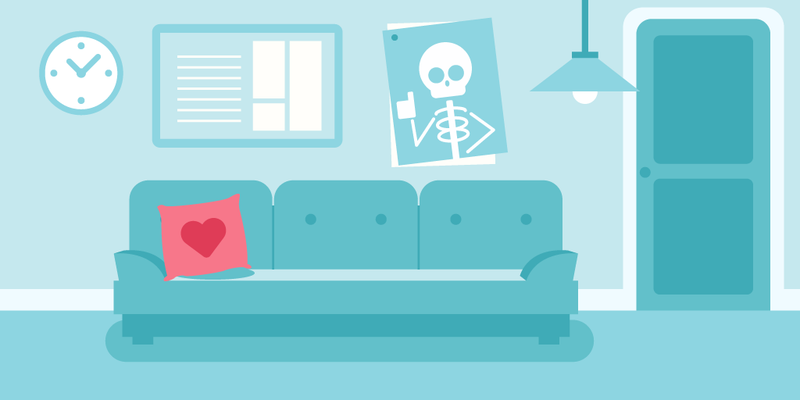Wouldn't it be great if hospitals completely did away with queues and waiting? A brave new world with no grief, awkward watch-checking and anxious waiting.
But as we're stuck in the world where waiting is the name of the game, the only thing left for us to do is to make the experience tolerable or — dare we say it? — enjoyable.
When it comes to patient experience in waiting rooms, many healthcare facilities are, sadly, lagging behind. What’s even sadder is that it only takes 4 simple steps to modernize your waiting room experience.
1. Update the layout

First things first, if your patients find your waiting room experience lacking, perhaps it’s time to update the layout.
Open rooms with lots of space is a surefire way to create an inviting atmosphere. So many hospital waiting rooms are guilty of making patients feel cramped, locked-in and uncomfortable.
Good lighting is also an important part of improving the layout of your waiting room, and there are some nuances to consider. The most important thing is that artificial light comes across as harsh. Natural daylight is a must, as it puts people at ease and creates a sense of comfort and serenity.
When there’s light, there’s also color. Don’t be shy and add a dash of green to the palette. Nature and greenery positively impact our well-being and relieve stress: a couple of flower pots, while not much, help create a more positive atmosphere.
Another thing that can give your facility a distinct and positive look is artwork. Barren walls are a bane of any hospital visit: there’s nothing to hold your attention, and it looks oppressively sterile.
Hang some nerve-calming pictures of landscapes and animals. At the very least, they would surely make your waiting room stand out.
2. Add comfy furniture

Plastic chairs are cheap to get, but they’re also synonymous with discomfort. Couple that with excruciating wait times until you get treated, and a simple piece of furniture becomes a torture device for the modern age.
As hospital are, generally, under tight budget constraints, it might seem more logical to opt out for cheaper options. However, comfort is the keyword here. So much so that some dentist waiting rooms even have massage chairs, to provide that extra bit of comfort.
A sensitive topic to keep in mind is that a significant portion of population is, well, overweight. This means that healthcare furniture needs to account for specialized needs by providing extra large and durable chairs.
Aesthetics play a major role, too. Your choice of colors and fabric may reinforce a branded look and create a consistent visual experience.
3. Provide entertainment

Now, when we say “entertainment” or “activities”, we don’t necessarily mean something physically involving. When it comes to waiting rooms, activity is anything that helps take you mind off of molasses-like passage of time.
The reason this is important is that our perception of time passage differs quite a bit from the actual time passage. What is, in reality, five minutes may feel like hours when we’re bored out of our minds.
But dangle a shiny objects before us and we, like kids, forget everything else. Providing a distracting activity, no matter how trivial it is, is how hospitals can make wait times feel shorter and keep patients from nervously checking the clock twice a minute.
On the first glance, a simple TV may significantly improve the quality of life for those who wait their turn. However, a study in Clinic Design: Enhancing the Patient Experience through Informed Design, by Gary A. Nyberg and Christine Guzzo Vickery found out that:
Only 41% of patients expressed wish to watch TV.
95% of patients spend their wait time reading.
57% of patients prefer to use a mobile phone to entertain themselves.
In the days of old, waiting rooms offered magazines, newspapers and books. Though we are in the 21st century, the activities don’t have to change that drastically. The modern waiting rooms may offer the same good ol’ magazines, newspaper and books — only now in a digital format.
Tablets not only let you read publications or browse the Internet, they come equipped with apps and games. Be it a kid or a kid at heart, no one is able to say “no” to quick, meaningless entertainment in the face of long waiting.
4. Make use of technology

If TVs don’t cut it anymore as entertainment, perhaps there is another use for them?
Although reducing wait times should be a top priority, long waits aren’t always avoidable. As we’ve mentioned before, providing entertainment is one way to alleviate the pains of waiting. The other is even simpler: provide accurate wait times.
According to studies, over 55% of patients wish they had access to estimated wait times on a screen in a waiting room. Additionally, 61% of patients would like a text message notification to alert them about their turn.
Some practices go the way of fancy restaurants now, by giving patients a pager that buzzes when their turn comes. This way, you can go outside or to the bathroom without worrying about missing your cue.
As the number of patients is often overwhelming, however, keeping so many pagers handy can be problematic. Phones, on the other hand, is a much more accessible solution:
A patient enters their phone number upon sign-in via an iPad station.
The patient joins the waiting line and can monitor the queue progress on the TV screen.
As the patient’s turn comes, they get a notification no matter where they are.
As a result, patients are given peace of mind, as there’s one fewer thing to stress out about.
For better or for worse, waiting is a natural part of today’s healthcare practices. That is not to say, however, that the waiting experience cannot be made tolerable, if not outright pleasant.
Healthcare facilities need to use whatever they can to make patients’ life easier. Put the "care" part back in the "healthcare"!






